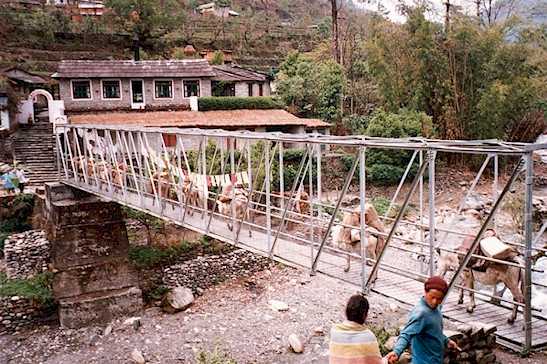
Anne Desjardins' interest in corn's Asian beginnings while working in Nepalese villages as a Peace Corps volunteer in 1972
New Website Traces "Long, Strange Trip" of Corn
By Jan Suszkiw
June 21, 2004
A chronology of corn's migration from Mexico's Aztec civilization to the Silk Road to China is now available on the Web at:
http://www.nal.usda.gov/research/maize/introduction.shtml
Prepared by Agricultural Research Service chemist Anne Desjardins and technical information specialist Susan McCarthy, the website details a timeline for corn's worldly travels, starting with the crop's only known center of domestication in "Mesoamerica," a region comprising south-central Mexico and adjacent areas of Central America.
The authors cite some interesting sources, including Christopher Columbus, the first known European to encounter corn, Zea mays, during the first of his four sea voyages starting in 1492. While in Cuba, Columbus purportedly logged an account in which "... [his party] had seen many fields … also of a grain like panic-grass that the Indians call maize. This grain has a very good taste when cooked, either roasted or ground and made into a gruel."
Chapters 2-6 chronicle early events in corn's five-century journey from Mesoamerica to Europe, Africa and Asia, with subsections providing historical context. A section titled "Aztec Records of Maize and Teosinte" notes those Indian people's early writings on corn.
Another section, "Maize Crossed Asia Within 100 Years," reflects Desjardins' interest in corn's Asian beginnings while working in Nepalese villages as a Peace Corps volunteer in 1972. "As I ate my maize [porridge], I wondered how an American crop had become a staple food in a remote region of the Himalayas," she writes in the website's introduction. "My neighbors were convinced that their maize, or makai, was 'local'... ."
Creating the website, 30 years later, reaffirmed Desjardins' belief that Asian and African farmers rapidly adopted corn, an American crop plant. Today, at the ARS National Center for Agricultural Utilization Research in Peoria, Ill., she seeks ways to protect corn, wheat, barley and other grain crops from diseases like Fusarium head blight. McCarthy, Desjardins' collaborator, works in the Public Services Division at the ARS National Agricultural Library, which posted the website in February.
ARS is the U.S. Department of Agriculture's chief scientific research agency.
